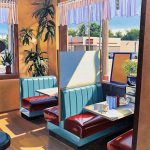“People of the Big Voice”

John Falcon (NaHeKah), seated next to Lucy Waukon, ca. 1910, photo by Charles Van Schaick as seen in the new book “People of the Big Voice”.
Wisconsin Historical Society Press entered my radar over the past year due in part to the ability of the Internet to increase visibility, but also because of the organization’s frequent collaborations with Historic Milwaukee. What struck me as a photographer were some of their recent books, including the latest offering, People of the Big Voice.
Many of the newer WHSP publications are heavy on gorgeous modern photography of barns or notable Wisconsin homes, while others focus new camera lenses on objects beloved by collectors and history buffs. What makes this book a paradigm shift is the rare documentary and set-based glass plate photography of Charles Van Schaick.
Much about the Black River Falls studio photographer, who plied his trade there from 1879 to 1942, is unknown. There is precious little to indicate Van Schaick’s motivation or passion to document historic Ho-Chunk meetings and celebrations or why so many of the resident natives trusted him.
What results is perhaps the most fair and intimate look at a people who lived on Wisconsin soil for centuries. In the 1950s, the collection would be discovered by workers and eventually fall into the hands of a librarian who sorted through hundreds of plates, discarding many of them. What remains is only a cross-section of the sixty years worth of people and street scenes Van Schaick orchestrated.
 Paging through this book, one can become entranced by the serious faces and fashion styles that were evolving from living among the new settlers. The text, written by group authors Matthew Daniel Mason, Amy Lonetree, Tom Jones, and Michael Schmudlach, reveals not only the stories and lives behind the photos, but historical context to the location, living conditions, spirit of the people, and meaning within each photograph. During this time, encounters with other tribes influenced fashion not typically associated with the Ho-Chunk and Ojibwe nations. A man wearing a headdress was worn to indicate his importance and position in the tribe, but was not normally worn in Wisconsin tribes until the 1870s.
Paging through this book, one can become entranced by the serious faces and fashion styles that were evolving from living among the new settlers. The text, written by group authors Matthew Daniel Mason, Amy Lonetree, Tom Jones, and Michael Schmudlach, reveals not only the stories and lives behind the photos, but historical context to the location, living conditions, spirit of the people, and meaning within each photograph. During this time, encounters with other tribes influenced fashion not typically associated with the Ho-Chunk and Ojibwe nations. A man wearing a headdress was worn to indicate his importance and position in the tribe, but was not normally worn in Wisconsin tribes until the 1870s.
The photographs then become both documentary and fiction. If someone came looking for historical fact that the Ho-Chunk individuals pictured lived a certain perceived way, it is false. The people entering Van Schaick’s studio knew what it meant to have their picture taken and wanted to showcase how they saw themselves. In adopting certain postures and European clothing, they imagined themselves as part of the new society forming around them.
Just as interesting is the fine-detail in the pairs of young women, sometimes dusted with a blotch of homemade rouge to emulate what they saw in the makeup. The more endearing photographs, however, were of women that seem to let their guard down and act naturally for the lens. They sometimes hint at the Victorian-era photos of decades earlier with subjects looking off-camera.
A few of these photographs were of special interest to researcher Amy Lonetree, who discovered her still-living Grandmother as a young woman in the pictures. When she took the photos to her, the elderly woman lit up with instant remembrance of the day and the others in the photoshoot.
 The photos for Lonetree, who contributes a significant section of the 8.5 by 11″ photo book, not only appreciates the collection as a glimpse of her descendants in Wisconsin, but that Van Schaick took such an interest in representing his customers. Going to the studio photographer one Saturday afternooon was more than just making a home video of the family, but a significant event to remember a specific moment in their lives.
The photos for Lonetree, who contributes a significant section of the 8.5 by 11″ photo book, not only appreciates the collection as a glimpse of her descendants in Wisconsin, but that Van Schaick took such an interest in representing his customers. Going to the studio photographer one Saturday afternooon was more than just making a home video of the family, but a significant event to remember a specific moment in their lives.
People of the Big Voice: Photographs of Ho-Chunk Families by Charles Van Schaick (1879-1942), can be ordered from the WHSP website, along with a treasure trove of other recent photo-heavy publications in the Fall 2011 catalog, or in the Wisconsin Historical Museum’s store in Madison on the Capitol Square.























[…] Read the rest Book Review: Book Review: People of the Big Voice | ThirdCoast Digest […]
my grand-daughter’s grandpa was chief of the Ojibewe Wisconsin tribe. Her pa still lives on the land up north. These images remind me of another famous photographer of Native-Americans….Curtis.
Well written review. I visited the Ho-Chunk Res Pow wow this summer with my wife and sons and thoroughly enjoyed the experience, especially the going home song that the top drum group beat and sang out with passion.